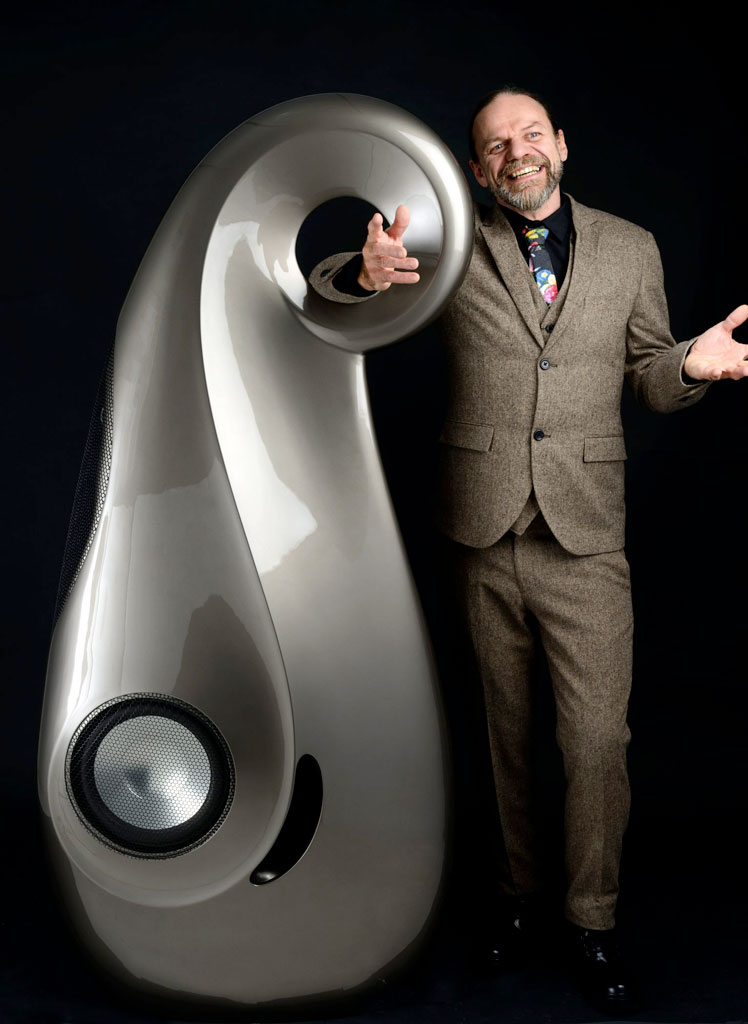Design and Specifications
The following description and review is of the G1 with a mechanical crossover that allows for passive biamping, which is how my G1 is set up.
The Vivid G1Giya is a four-way design with five drivers. Two 11″ side-firing anodized aluminum woofers are mounted on opposite sides of the cabinet and mechanically coupled. Each woofer is vented to the rear through an opening tuned to 23Hz. The bass drivers themselves are loaded by the curvilinear tapering tubes, which in turn are tuned to 100Hz.
There is a 1″ tweeter and a 2″ midrange, each an aluminum catenary dome, and a 4.9″ aluminum-cone lower-midrange driver. The tweeter and midrange are very delicate and care must be taken to shield them from any contact. It’s my understanding that the drivers have cylindrical magnets that couple a large-diameter vent behind the diaphragm to the tapered tubes. I wasn’t about to open up the speakers. I don’t really understand how this works, but the Vivid website has a thorough explanation that I invite you to read.
Initial Impressions
When I first received the Vivid Giya G1, I simply placed them in approximately the same locations I place my B&W 800D. I did not attempt any tweaking, other than to make sure the left and right speakers were pointed at the outer edges of the listening chair and were approximately equidistant to the listening position. I also did not recalibrate my Lyngdorf RP-1 Room Correction Device or rearrange any cables. I just connected them and started some music. The sound was immediately more extended, more defined and more coherent than the B&W 800D and I felt a mixture of relief and jubilation. I was very sure that the Vivid Giya G1 would sound better than my B&W 800D, but you never know until you actually listen. The first 30 minutes confirmed the decision I had made to go with the G1s. The thought also crossed my mind: “I want these speakers…” I quickly shut those thoughts out of my mind.
Though I adjusted the speakers’ positions somewhat, I found that they were best in the same locations that work with the B&W 800D, except for being slightly wider, at 9.5 feet apart. I also decided to go with the manual’s recommendation and toe-in the G1s so that the center line of each midrange crossed approximately 12 inches in front of the main listening position. I was skeptical about this positioning, but I immediately was impressed by its effects. First, the Giyas’ radiation patterns are so wide that there was absolutely no loss in the soundstaging or sense of presentation. Second, this positioning actually created an even more realistic soundstage in front of me. Finally, as was predicted by the manual, the soundstaging at the far left and right listening positions about 6 feet to the left and right of the center listening chair improved significantly. I decided to leave the speakers in this position for at least the initial “analytical” stage of the review.
- ← Previous page
- (Page 2 of 4)
- Next page →


I must say that I always very much enjoy reading your reviews, perhaps that is the lawyer in me. I think thatthe highest compliment that a reviewer can pay to a product he reviews is to buy it.
Just in case you did not know, the UK HQ of Vivid is in Sussex, England, also home to some of the finest speaker manufacturers in the world, Harbeth, Spendor and B&W.
Xlnt review !
I own the G-2 the G-1 are just too big for my living room. I changed all my equipment around these speakers but the biggest improvement by far was when I changed my Bel Canto top of the line digital stack to an older DCS P8I which I sent to the factory in england shortly after I got it to an MK2 upgrade. The improvement in sound was dramatic.
Dear Ed, Great review, I’m a B&W 800D person. Question is re the RP-1, where does it fit with the passive bi-amping???? Do you run 2 sets of interconnects from your pre-amplifier to the RP-1 & then 2 sets speaker cables from the outputs RP-1 to your 4 monoblocks?? Or is it done another way!!! Thank you, Peter.